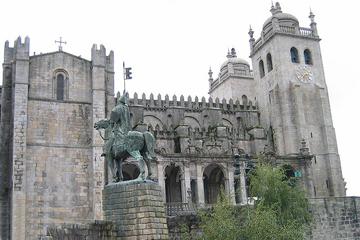
Originally a Romanesque church from the 12th century, the Porto Se Cathedral was rebuilt with a Gothic style about 600 years later. Like other major churches in northern Portugal, this twin-towered cathedral boasts remodeling design by the famed Italian architect and painter Nicolau Nasoni. Perhaps this is why the western façade and interior are undeniably Romanesque. Visitors should take note of its gilded main altar and its silver Altar of the Sacrament.
On the left hand aisle is the statue of Oporto’s patron saint, Nossa Senhora de Vendoma. The interior is decorated by azulejos (blue ceramic tiles), installed in the 18th century.
Apart from the church’s architectural treasures, it is also famed for its view – the terraces on the north and the west sides of the church provide stunning photo opportunities for capturing Oporto’s labyrinthine streets and dwellings.
If planning a walking tour of Oporto, the cathedral should be focal point as it is not only one of Oporto’s most important monuments, but one of Portugal’s, as well.
Inside the church, you will find a marble plaque memorializing the lives lost reclaiming the cathedral from the Spanish soldiers that briefly held it during the Battle of Amarante during the War of the Oranges. Most interesting is that the plaque is backed with magnetite for the purpose of drawing travelers’ attention to the church and the plaque by scrambling their compasses.
The Se Cathedral is near the center of town, but before you visit it or any other attraction in Porto, you may want to take a few hours and get a crash course in Portuguese. Also found in the center of town is the Fast Forward Language Institute, which offers a variety of language courses, including a 3 hour-long "Portuguese for survival" course. After taking this course, practice reading the church's informational literature, then practicing speaking at a bar or restaurant on the Ribeira.